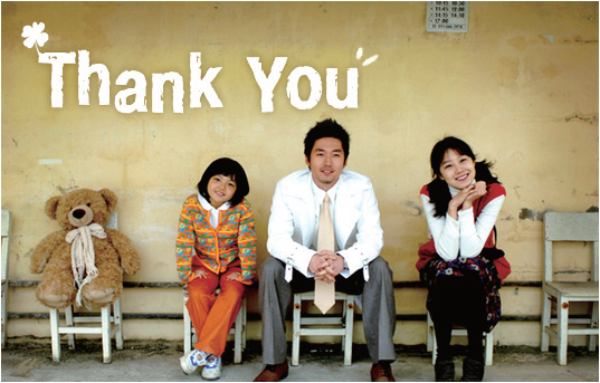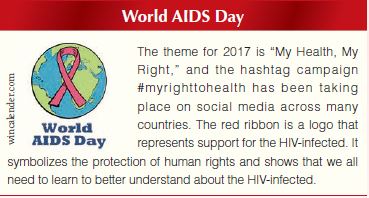
The World Health Organization (WHO) designated December 1st of every year as World AIDS Day in 1988 to raise awareness of Acquired Immunodeficiency Syndrome (AIDS). It introduces different themes every year, and various campaigns are held based on these themes. South Korea is also carrying out various events such as AIDS prevention campaigns and free hug campaigns. On the occasion of World AIDS Day on December 1st, the Sungkyun Times (SKT) discusses the negative perceptions on AIDS as well as the efforts to improve awareness of AIDS.
All About AIDS
HIV and AIDS
AIDS is a disease caused by a virus called Human Immunodeficiency Virus (HIV) that destroys a person’s immune system, which eventually makes the person susceptible to infections and diseases. There are three different ways how HIV is transmitted from person to person. The most common way is through sexual transmission. This means that HIV is transmitted when there is contact with sexual fluids, such as rectal, genital, or mucous membranes of an infected person. Another way is through perinatal transmission, where the virus is transmitted before or during birth, or while breastfeeding. The last possibility of virus transmission is through blood transmission. Blood transmission could mean blood transfusions or the use of injection needles. Meanwhile, there are three stages of HIV infections, and each stage has different symptoms. The first stage is acute HIV infection, and most people at this stage have flu-like symptoms, such as fevers, headaches, and rashes. The second stage of HIV infection is chronic HIV infection, where HIV continues to multiply in the body and weakens the immune system of the infected person without any symptoms. AIDS is the last and the most severe stage of HIV infection. The person’s body cannot fight against infections due to their weakened immune system, which causes the person to eventually die.
Reality of AIDS
There are 36.7 million HIV-infected people out of 7.442 billion worldwide, which means that 0.5% of the whole population is HIV-infected. The death of HIV-infected people has decreased by 48%, from 1.9 million deaths in 2005 to one million in 2016. The total number of deaths has decreased ever since Antiretroviral Therapy (ART) was made available in 2010. The number of new HIV infections in Korea, however, is actually increasing every year, while the number of new infections around the world is decreasing. HIV-infected people in Korea numbered only 7,656 in 2010 but have increased to over 10,000 in 2017. While the number of people infected is increasing, the education level of AIDS prevention continues to be very low and there is no system in place to manage this situation. Education on HIV and AIDS is not mandatorily included in sex education classes in Korea, which creates a very low awareness of the disease. It is also difficult to identify people that are infected due to the anonymous HIV tests, and it is impossible to systematically manage and supervise infected people due to the possibility of violating human rights.

Misperceptions of AIDS and the Truth
Fatalness of AIDS
In Korea, Pine Wilt Disease is referred to as “Pine Tree AIDS,” due to its fatal nature where all infected trees die within a few weeks because there is no treatment for this disease. This example shows a crucial misconception of Korean society that still believes that AIDS is an incurable disease. In the past, AIDS was a deadly disease with an unknown cause. AIDS, however, is no longer necessarily a fatal disease. Even if the patient does not partake in any treatments, it takes around 10 to 20 years to die after being infected with HIV. When the patient gets treatment, the life expectancy for the HIV-infected person is improved to the extent where it is the same as healthy people. According to research from the University of Bristol in the United Kingdom (UK), 20-year- old patients who started to get treatment in 2008 are expected to live until 78 years old. With these recent improvements of AIDS treatments and drugs, scientists are expecting to completely cure AIDS soon.
AIDS Transmission Methods
One of the most common misconceptions about AIDS is the ways the virus is transmitted. A lot of people still believe that HIV can be easily transmitted through simple physical contacts that often happen in our daily lives. However, it has been proven by the Center for Disease Control and Prevention (CDC) that 90~99% of the HIV in body fluids is inactive outside of the body. This proves that there is a very low possibility of being infected with HIV by simply having contact with body fluids of the HIV-infected. Despite the presence of HIV in all kinds of body fluids, the virus is only infectious in blood, sexual fluids, and breast milk. Thus, AIDS is hardly transmitted through common activities in our daily lives. Additionally, medications that are taken during the early phases of the infection radically reduce the possibility of HIV transmission. The University of North Carolina carried out a clinical trial on HIV-infected people and their uninfected spouses to study the possibility of HIV transmission. From this clinical trial, it was shown that the rate of HIV transmission to the uninfected spouse was 96% lower in the cases where the infected person had started medications in the early phase of the infection than the cases of starting treatment after the disease got worse.

Results of the Social Stigma of AIDS
In the past, AIDS was referred to as “punishment from God,” which was why HIV-infected people were discriminated against by society. The fear of being discriminated against and stigmatized is one of the most crucial reasons why the HIV- infected in Korea tend to conceal their infections. Even though the Korean government bears 90% of the medical expenses for the HIV-infected, 660 HIV-infected, which is about 5.5% of the infected, still did not register to take medications due to the fear of revealing their infection status to other people. According to the People Living with HIV (PLHIV) Stigma Index of Korea in 2016 that was carried out by The Joint United Nations Programme on HIV/AIDS (UNAIDS), the “internalized stigma” index of HIV-infected people was recognized as one of the highest. 75% of people with HIV blamed themselves, while 64.4% felt guilty of having the disease, 59.6% reported having low self-esteem, and 36.5% had experienced suicidal urges. The result of this “internalized stigma” index shows the extent of Korean society’s stigma on the HIV-infected.
Efforts on Improving AIDS Awareness
Education on AIDS
In Korea, there are various approaches to educate students on AIDS in order to change negative perceptions towards AIDS. One of the most interesting approaches is through a cultural approach, such as musicals. On the occasion of World AIDS Day, a mini cultural festival for students called “AIDS FREE, KNOW AIDS” has been held by the Daegu Metropolitan Office of Education and Daegu-Gyeongbuk Branch of Korean Alliance to Defeat AIDS since 2011. This event was first launched with the hope of lowering the negative perception of AIDS, as well as improving the overall awareness of AIDS so that students could deal with AIDS on their own terms. In another case, a teen AIDS prevention musical called R U Ready was performed for students at Haesung International Convention High School in October of this year. Students were involved in all aspects of the play, which helped the musical to be an effective educational tool for the students.
Raising Awareness Through the Media

The media has been further stimulating the fear of AIDS by releasing reckless contents about AIDS. Many entertainers, however, have been making efforts to ease these fears and reform the misperceptions about the epidemic. One of the examples is a Korean drama called Thank You that aired in 2007. This drama was about a young girl living with AIDS, whose intention was to reduce prejudices and debunk misperceptions about AIDS. Based on the survey carried out by the Korea Federation for HIV/AIDS Prevention, 75.4% of the respondents said their perceptions, as well as prejudices towards HIV-infected people, changed through the drama series. The Seoul Broadcasting System’s (SBS) Cultural Foundation concluded that it is more effective in debunking misperceptions and reducing prejudices through entertainment rather than broadcasting information through the news. Promotion of HIV testing is one of the most important factors needed in society to prevent the excessive spread of the disease. Many celebrities, therefore, are making efforts to promote them. For example, the former President of the United States (US), Barack Obama, actively promoted the issue of receiving HIV laboratory tests. Additionally, Prince Harry of Wales, along with celebrities such as Rihanna took HIV tests together on World AIDS Day in 2006.
Supporting AIDS Through Marketing

Another way to promote AIDS prevention is through marketing. One of the most recognized brands that supports raising awareness and funds to help AIDS prevention and elimination is (PRODUCT)RED. Recently, this brand collaborated with Apple and has become very popular. (PRODUCT)RED sold multiple versions of the iPhone 7 and 7 Plus Red marked with the (PRODUCT)RED logo to categorize them as special edition. The (PRODUCT)RED brand has raised $475 million and impacted over 90 million lives over the past 11 years. In Korea, there is a social cooperative cafe for HIV-infected people called Big Hands, which means big applause, big help, and big encouragement for the HIV-infected. The cafe was established in 2013, with the intention of supporting the HIV-infected. 100% of the proceeds are used to support AIDS-related welfare services. Big Hands is run by HIV-infected people along with healthy people, and the number of people both visiting and working in this cafe has been increasing since 2013.

People living with HIV are going through struggles mainly due to society’s stigmas, not the pain of the disease itself. People should remember that AIDS is no longer a fatal disease that should be feared and avoided. Along with all the various efforts around the world to raise awareness and support AIDS, the SKT hopes our society learns to accept the HIV-infected instead of discriminating against them.
